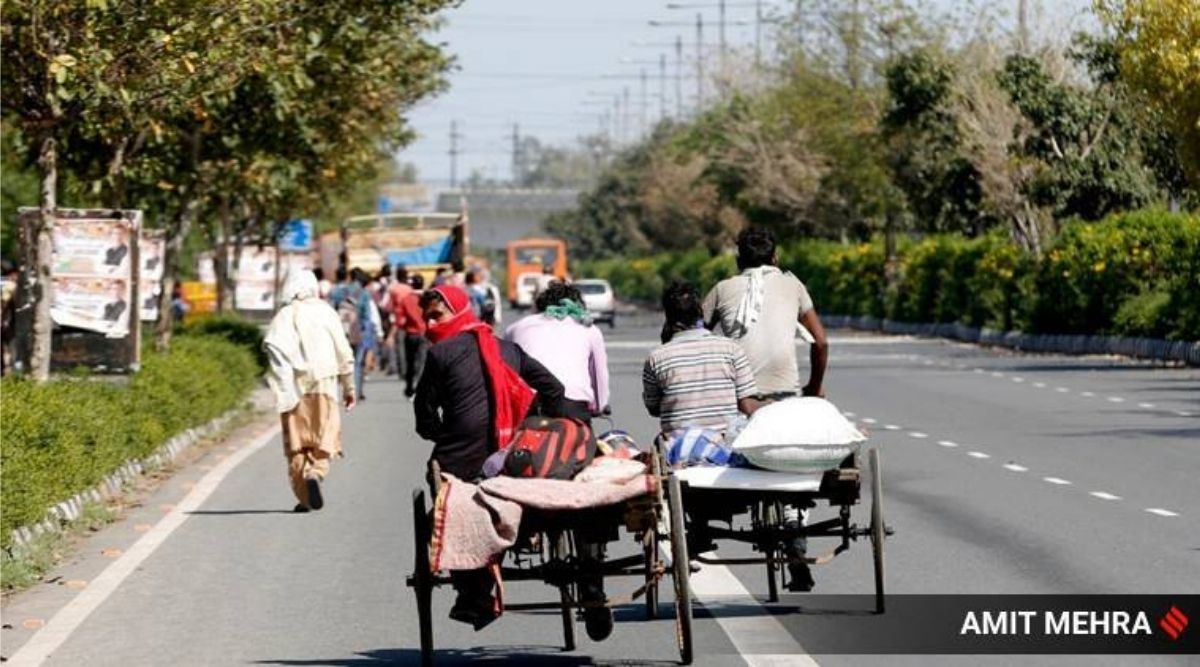Updated: March 25, 2022 3:58:16 am
 Covering close to 4,000 people in 11 states, the survey highlighted the extent of widespread hunger and a deterioration in the quality of diets compared to the pre-pandemic period.
Covering close to 4,000 people in 11 states, the survey highlighted the extent of widespread hunger and a deterioration in the quality of diets compared to the pre-pandemic period. Two years ago, the imposition of the national lockdown in India had disastrous consequences for the working poor, especially the migrant labour. In October 2020, The Right to Food Campaign and associated organisations had conducted the first Hunger Watch survey (HW-I). The main objective of HW-I was to document the economic distress and hunger caused by the lockdowns and catalyse public action for relief. Covering close to 4,000 people in 11 states, the survey highlighted the extent of widespread hunger and a deterioration in the quality of diets compared to the pre-pandemic period.
In 2021, India was hit by a devastating second wave of infections. While no nationwide lockdowns were announced, the speed and severity of the spread meant inevitable disruptions to lives and livelihoods. Most states imposed curfews and restrictions on economic activity. The economy contracted by 6.6 percent in 2020-21. While the economy is estimated to grow at 8.9 per cent in 2021-22, the low base effect means that per capita incomes have still not recovered to pre-pandemic levels. Unemployment rates continue to be high.
Given the prolonged nature of the pandemic and the spike in indebtedness caused by unforeseen medical expenditures through the second wave, it was important to capture the continued economic distress. The second round of the Hunger Watch survey (HW-II) was conducted in December 2021-January 2022. While not conducted with the same respondents, HW-II followed a methodology similar to that used in HW-I. Close to 6,700 respondents were interviewed in person across 14 states; 73 per cent of these were based in rural areas, and 71 per cent of them were women. The survey focused on understanding food and income insecurities among the informal sector.
Food insecurity was widespread — 79 per cent of the overall sample reported experiencing at least one of the eight conditions of food insecurity from the Food and Agriculture Organisation’s Global Food Insecurity Experience Scale (GFIES) in the month preceding the survey. The eight conditions range from worrying about not having enough food, to not being able to eat a diet of sufficient quality or quantity, to running out of food and having to go without eating a whole day. A quarter of the sample reported “severe” food insecurity, that is, they experienced seven or eight of the conditions.
The situation was worse in urban areas, where 87 per cent reported any food insecurity, and 28 per cent reported severe food insecurity, compared to rural areas where the numbers were 76 per cent and 24 per cent respectively. Nearly one-third of the respondents said that they or someone in their household had slept without eating in the month preceding the survey and 36 per cent said they had had to skip meals. This is a slight improvement compared to HW-I, where 48 per cent said that they had slept without eating at least once and 46 per cent said they had had to skip meals.
The bulk of the poor relies on cereals for food security. However, in HW-II only one in three households said that their consumption of cereals was sufficient for their needs. Two-thirds of households could not afford cooking gas in the month before the survey. This was higher in rural areas than urban.
Given that food intake needs are not being met, it is no surprise that diets are also nutritionally deficient. HW-II did not include a dietary quality assessment but elicited the frequency with which respondents reported eating nutritionally rich foods. 50-60 per cent of households said that they were able to consume eggs, milk, flesh foods or fruits fewer than two-three times a month; more than a quarter could only eat even the more affordable items like dark green leafy vegetables and pulses fewer than two-three times a month. Here rural households reported somewhat poorer diet quality than urban households, with the sole exception of fruits. Other differences were small.
People expect the situation to deteriorate further. Two in five respondents said that the nutritional quality of their food had worsened since the pre-pandemic period; a similar proportion said that the quantity of food they eat had also declined. These numbers are similar to those from HW-I — 59 per cent of urban households reported a deterioration in the quality of their diets compared to before the pandemic, compared to 35 per cent of rural households, though this could be the result of a higher baseline in urban areas. Overall, the outlook about the food situation over the coming months was pessimistic. Only one in six respondents said they thought their food situation would improve in the next three months.
While the HW-II sample was not designed to be nationally representative, it is indicative of the predicament in which many poor and vulnerable households find themselves – unable to secure either enough food (of any kind) or food of adequate quality. Against the backdrop of the recent National Family Health Survey (NFHS)-5 findings which show marginal improvements in child stunting and underweight among women and a significant deterioration in anaemia across the board, the HW-II findings are not an outlier. There is an urgent need to acknowledge the problem of hunger and take immediate action, including allocating sufficient resources to address the issue.
Raghunathan is a member of the Hunger Watch team, Sinha teaches at Ambedkar University, and Narayanan teaches at Azim Premji University
- The Indian Express website has been rated GREEN for its credibility and trustworthiness by Newsguard, a global service that rates news sources for their journalistic standards.

